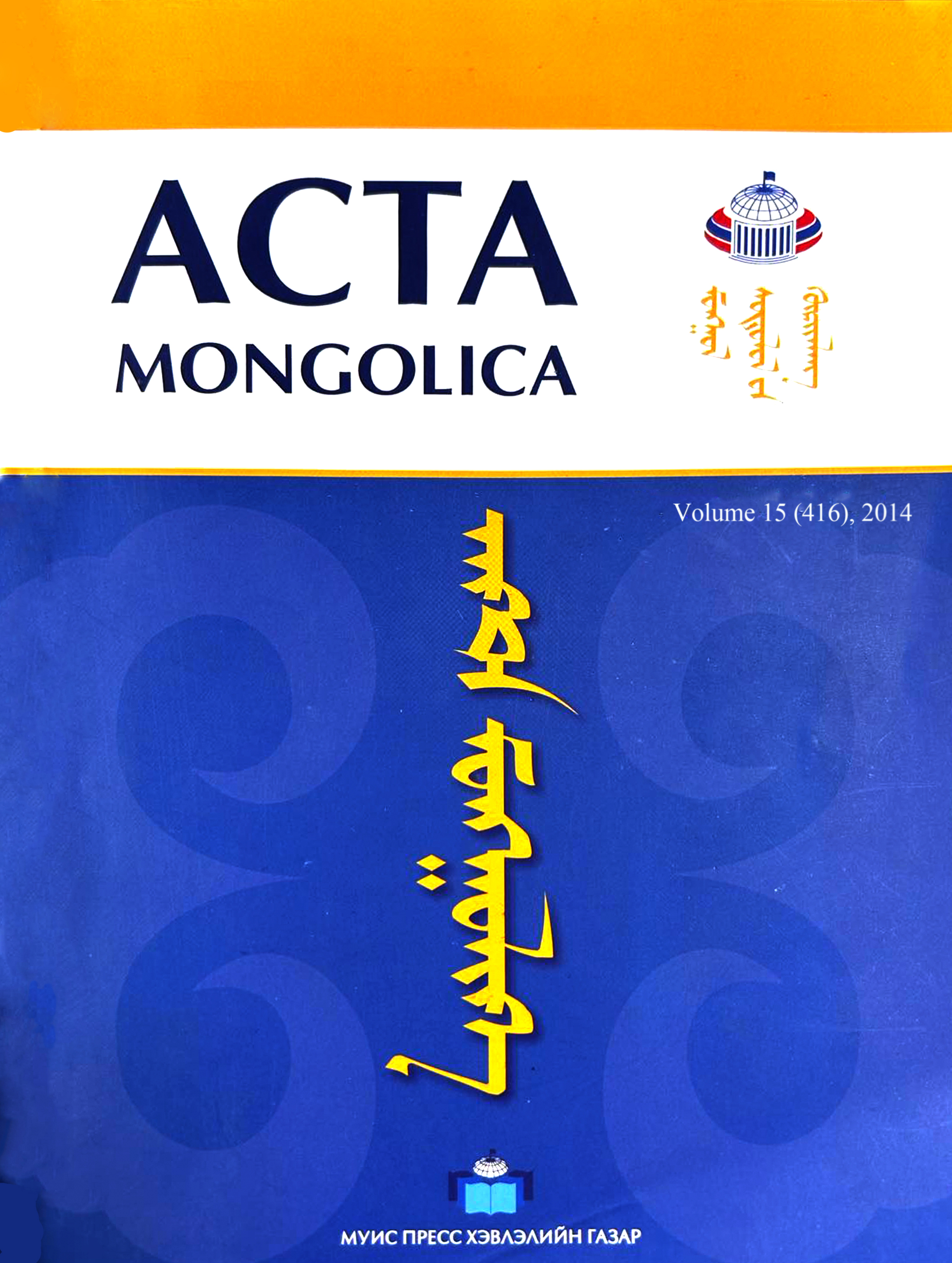МОНГОЛ ХЭЛНИЙ -Ч ДЭД БҮТЭЭВРИЙН ОНЦЛОГ, НАЙРУУЛГЫН ҮҮРЭГ
Main Article Content
Abstract
Morphemes are the smallest individually meaningful elements in the utterances of a language. Thus the morphemes are all meaningful. There are many methods for forming new words in the contemporary Mongolian language and one of them is word formation by suffixes. New word is formed with connected suffix to its root. However, the exciting phenomenon that new word has no semantic meanings is emerged when suffix connected to word roots. In morphology, it is called sub morph. The present article has reviewed the emerged meaning, structure and classification of those sub morphs in Mongolian language along with examples from the literature. There are many concepts such as sub tune, sub pronunciation, sub meaning and sub part in the linguistics and “Submorph” the object of our study is considered as one of those concepts. It is subunit at the lingual morpheme level and generally this subunit has no particular semantic meaning when it connected to word roots, but minor variance in the applied stylistics. Therefore the subunit of lingual morpheme has the different definition and title for instance E.A Zemskaya, E.C Kubryakova “Sub morph”, N.M Shanskii “Affecksoide”, D. S. Vort “Morpheme no semantic meaning”, V.V Lopatin “redundant” or “insert” morpheme, G. O Vinocur “ variation of root”, A. I Moiseev “quasi-morpheme” etc. Although these titles seem different, they have defined the main characteristics of sub morph. Many sub morphs namely as -га4, -с, -м, -ж, -ч, -р, -аа4,-ц, -н, -т are found in Mongolian language, among them -га4, -с suffixes are mostly used in word formation. As summarized from the preceding reviews and studies from the named scientists, sub morphs emerged in Mongolian language morphology is become the attractive object of the study.
Article Details

This work is licensed under a Creative Commons Attribution-ShareAlike 4.0 International License.
References
Ахманова О.С. “Словарь лингвистических терминов”, М.,1969.
Бадамдорж Д. “Монгол хэлний утга судлал”, Уб., 2001, 1-р дэвтэр. МУИС-МСДС, ЭШБ №13 (139), Уб., 1998.
Базаррагчаа М. “«Б» хэмээх оруулбар утгалбар нь угтвар бүтээврийн бүрэлдэхүүнд багтсан нь ”
МУИС, ЭШБ, XIV боть, (V дэвтэр), Уб., 1999.
Базаррагчаа М. “Утгын чуулган”, Уб., 2002.
Бертагаев Т.А. “Морфологическая структура слова в монгольских языках”, М., 1972.
Болд Л. “Орчин цагийн монгол хэлний дагавар”, Уб., 1986.
Болд Л нар /Ред/, ШУА, ХЗХ, Монгол хэлний дэлгэрэнгүй тайлбар толь, Уб, 2008.
Бэшэ Л. “Монгол хэлний үйл үгийн угтварын тухай”, Studia Mongolica.TomVI Fasc12.
Ворт Д.С. “Морфонология славянского словообразование”, American Contributions to the VI International congress of slavists, I.The Hagui., 1973.
Дамбажав И. “Оюун билгийн мэлмийг нээгч аялгуу сайхан монгол үгийн дээж”, Уб., 2006.
Земская Е.А. “Современый русских язык”, М., 1973.
Идэрбаяр Б. “Монгол хэлний төсөөт үг”, Уб., 2005.
Кубрякова Е.С. “О типах морфологической членимости слов, Она же. Основы морфологического анализа”, М., 1974.
Лопатин В.В. “Русская словообразовательная морфемика проблемы и принципы описания”, М., 1977.
Моисеев.А.И “Основные вопросы словообразования в современном русском литературном языке”.
“Общее языкознание” (под общий редакцией А.Е.Супруна), Минск., 1983.
Өнөрбаян Ц. “Орчин цагийн монгол хэлний үйл үг бүтэх ёс”, Уб., 2000.
Пюрбеев Г.Ц. “Об одном типе синонимов в современной монгольской терминологий”, ШУА, ХЗХ, “Нэр томьёо судлал” №8, Уб., 2006.
Туяа Ш. “Үг бүтэхүйн утга зүй”, Уб., 2005.
Цэвэл Я. “Монгол хэлний товч тайлбар толь”, Уб., 1966.
Цэцэнцогт Ш, Монгол үгсийн язгуурын толь, Жан Жияа Кэү, 1988.
Чурганова В.Г “О предмете понятия фономорфологий” («Известия АН СССР. Серия литературы и языка» вып.4), М., 1964.
Шанский Н.М “Исследования по современному русскому языку” (Издательство
Московского университета), М., 1970.
Pual R.Kroeger Analyzing Grammar (An Introduction), New York, 2005, p 12

